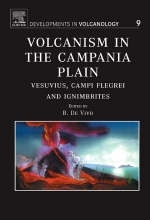
Volcanism in the Campania Plain
Elsevier Science Ltd (Verlag)
9780444521750 (ISBN)
The book deals with the study of three important volcanisms in the Campania Plain: Vesuvius, Campi Flegrei and Ignimbrites. The knowledge of the volcanic evolution of Vesuvius and Campi Flegrei has a particular relevance because of the hazards that these volcanoes pose to the about 1.5 million people living in the Neapolitan area.
The contributors to the volume bring new data (experiments on volatile solubility, fluid-melt inclusions, tectonic, geophysical, isotope, geochronology), which are helpful in the creation of new models for a better understanding of the behaviour of the volcanic systems. In particular a hydrothermal model is used to explain the ground movements (bradyseism) at Campi Flegrei. To develop such a model, the authors use an analogue for the evolving Campi Flegrei sub-volcanic system, the model of the porphyry mineralized systems. For Campanian Ignimbrite the authors highlight the impact crystal-liquid separation has on melt compositional evolution and particularly focus on trace element and Th isotope evidence for open-system processes in the magma body associated with the Campanian Ignimbrite.
The authors, for their interpretations, utilize thermodynamic and quantitative mass balance modelling of major and trace element data and semi-quantitative limits on Th and Sr isotopes to evaluate the role of crytal-melt separation, magma-fluid interaction, and assimilation of wallrock on the geochemical evolution of the Campamian Ignimbrite.
Benedetto De Vivo, after graduation (1971) from the University of Naples Federico II in Geological Sciences and military service (1972), worked for private companies operating in Italy, Africa, and Central America in the field of ore deposits, geochemical prospecting, environmental geology, and hydrogeology (1973–1977). Later, he was a Researcher at CNR-Roma, Italy (1977–1987), Associate Professor in Applied Geochemistry (1987–2000), and Full Professor in Geochemistry at the University of Napoli Federico II (2000–2017). He was a research fellow at the Colorado School of Mines (1978) and at US Geological Survey, Reston, VA (1982 and 1992); Chairman of the Working Group “Inclusions in Minerals of the International Mineralogical Association; Member of the Editorial Board of GEEA (2004–2007), Minerology and Petrol (1997–2007), American Mineralogist, and Chief Editor of Journal of Geochemical Exploration (2007–2017). His research interests span a wide range of topics including geochemical prospecting, fluid and melt inclusions studies on volcanic and sub-volcanic systems, and environmental geochemistry. He has published about 300 papers (in top international peer-reviewed journals), editing different special volumes (Journal of Volcanology and Geothermal Research, European Journal of Mineralogy, Institution of Mining and Metallurgy, and, Minerology and Petrol), and has authored four text books (in Italian) in geochemical prospecting and environmental geochemistry. He was nominated (2001) as Fellow of the Mineralogical Society of America and appointed as an Adjunct Professor at Virginia Tech, Blacksburg, VA, USA (2006), Nanjing University, China (2016), and Hubei Polytechnic University, Huansgshi, China (2019). He was the recipient of the 2019 Gold Medal Award of the Association of Applied Geochemists for outstanding scientific contributions and achievement in applied geochemistry.
Preface(B. De Vivo).
1. The volcanological history of the volcanoes of Naples: a review (R. Scandone, L. Giacomelli, F. Fattori Speranza).
2. The Pleistocene extension of the Campania Plain in the framework of the southern Tyrrhennian tectonic evolution: morphotectonic analysis, kinematic model and implications for volcanism (E. Turco et al.).
3. Rapid changes of the accomodation space in the Late Quaternari succession of Naples Bay, Italy: the influence of volcanism and tectonics (A. Milia et al.).
4. Gravitational instability of submarine volcanoes offshore Campi Flegrei (Naples Bay, Italy) (A. Milia, M.M. Torrente, F. Giordano).
5. The Campi Flegrei caldera boundary in the city of Naples (A. Perrotta et al.).
6. The Late-Holocene evolution of the Miseno area (south-western Campi Flegrei) as inferred by stratigraphy, petrochemistry and 40Ar/39Ar geochronology (D. Insinga et al.).
7. Magmatic-hydrothermal fluid interaction and mineralization in alkali-syenite nodules from the Breccia Museo pyroclastic deposit, Naples, Italy (L. Fedele et al.).
8. Structural control on the Upper Pleistocene ignimbrite eruptions in the Neapolitan area (Italy): volcano tectonic faults versus caldera faults (F. Bellucci et al.).
9. The magma feeling system of Somma-Vesuvius (Italy) strato-volcano; new inferences from a review of geochemical and Sr, Nd, Pb and O isotope data (M. Piochi, B. De Vivo, R.A. Ayuso).
10. Input of deep-seated volatile-rich magmas and dynamics of violent strombolian eruptions at Vesuvius (A. Cecchetti et al.).
11. The role of sulfur in promoting magmatic degassing and volcanic eruption at Mt. Somma-Vesuvius (J.D. Webster, M.F. Sintoni, B. De Vivo).
12. Influence of hydrothermal processes on geochemical variations between 79 AD and 1944 AD vesuvius eruptions (A. Lima et al.).
13. Petrogenesis of the Campanian Ignimbrite: implications for crystal-melt separation and open-system processes from major and trace elements and Th isotope data (W.A. Bohrson et al.).
14. A hydrothermal model for ground movements (bradyseism) at Campi Flegrei, Italy (B. De Vivo, A. Lima).
Author index.
Subject index.
| Erscheint lt. Verlag | 22.6.2006 |
|---|---|
| Reihe/Serie | Developments in Volcanology |
| Verlagsort | Oxford |
| Sprache | englisch |
| Maße | 165 x 240 mm |
| Gewicht | 740 g |
| Themenwelt | Naturwissenschaften ► Geowissenschaften ► Geologie |
| ISBN-13 | 9780444521750 / 9780444521750 |
| Zustand | Neuware |
| Informationen gemäß Produktsicherheitsverordnung (GPSR) | |
| Haben Sie eine Frage zum Produkt? |
aus dem Bereich


